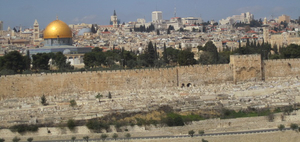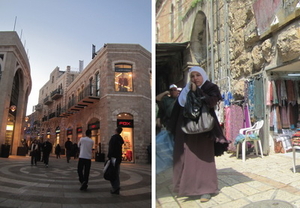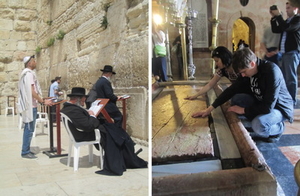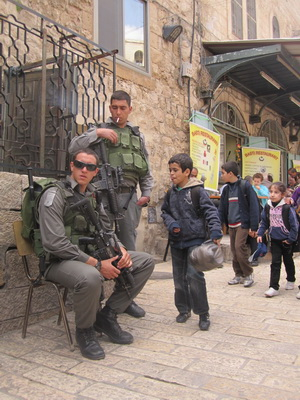
A trip to Jerusalem is an act of faith no matter what your convictions.
Jerusalem is the capital of Israel but it is not by any stretch of the imagination, an exclusively Jewish city. It throbs with a brash energy, pulsates with Semitic and Slavic rhythms and resonates with a sense of shared history unequalled in any other place on earth. In the words of one writer, it remains “a golden object of desire,” a site for pleasure, prayer and pilgrimage.
 West Jerusalem in particular has been radically transformed in the last couple of years, Canadian architect Moshe Safdie has for the last 40 years been largely responsible for building a New Jerusalem that rivals any temple Solomon could have built. Safdie’s latest project, the $150-million Mamilla pedestrian mall is a sublime high end souq of pale limestone which leads to the Jaffa Gate into the old city’s Christian quarter with its warren of cramped narrow streets.
West Jerusalem in particular has been radically transformed in the last couple of years, Canadian architect Moshe Safdie has for the last 40 years been largely responsible for building a New Jerusalem that rivals any temple Solomon could have built. Safdie’s latest project, the $150-million Mamilla pedestrian mall is a sublime high end souq of pale limestone which leads to the Jaffa Gate into the old city’s Christian quarter with its warren of cramped narrow streets.
More than 75,000 Canadians visited Israel last year, according to the Israel Government Tourist Office, triple the number that went 10 years ago. Tourism, especially religious tourism, has been increasing steadily, but the first question that everyone asks when you tell them you are leaving for Israel is “Is it safe?”
Israeli soldiers in uniform are everywhere and body checks when you walk into a shopping mall can be unsettling, but given the current political climate, understandable. But the overall atmosphere in Israel is much more relaxed now than it was 30 years when I last visited.
“Now is the best time to go because the uprisings are in every other country in the Middle East, not in Israel,” said Anastasia Zimmerman who was visiting from Calgary. ”Jerusalem has never been a “safe” city because too many people want a piece of it. It will never be completely at ease, but it has always been an exhilarating place to visit.” Another tourist, said she was “concerned for Israelis but not for myself. I feel I am well protected.”
 There is no better time of the year to go than in the weeks leading up to Easter and Passover when Jews are busy with their traditional spring cleaning, ridding their homes of any trace of chametz. Christians making their Lenten devotions throng the Garden of Gesthemene and the Mount of Olives. Across the Kidron Valley there is a breathtaking view of the storied pale stone fortress walls and the golden Dome of the Rock, Qubbat as-Sakhrah, the Islamic mosque on Temple Mount from which Muslims believe Mohammed ascended into heaven. Because of ongoing local tensions between Muslims and Jews the Dome of the Rock is now out of bounds to all but Muslims w ho may visit between 8:30 and 3 p.m. The old quarter is a religious Disneyland, a messy place divided between Arabs, Christians, Armenians and Jews, that smells of sweat, incense and spices. The Church of the Holy Sepulchre, in the Christian quarter, arguably the most important church in Christendom, is divided by ancient schisms and Christian rivalries. The keys to the church are held by a Muslim intermediary, and the place is run by six different denominations. Copts, Ethopians and Syrians are jointly responsible for the tomb although the outer chapel of the angel is a Greek Orthodox altar. Armenians have a basement chapel. Roman and Greek Orthodox Catholics run two small upstairs chapels on what was the site of Golgotha, the hill where Jesus was crucified. As gospel singing fundamentalists work their way through the streets, it is not unusual to hear a Muezzin chanting Adhan their haunting call to prayer, as Orthodox Jews stand in quiet prayer before the Western Wall, the site of Solomon’s temple Below the wall is the City of David, a steeply stepped archeological dig which includes the footprints of King David’s Palace, a sophisticated system of tunnels that provided the city with its water supply, and the recently uncovered Pool of Siloam, where according to John (Chap 9.) Jesus cured a blind man. No visit to Jerusalem would be complete without a visit to Yad Vashem, the Holocaust memorial and archives. Once you enter, there is no turning back. It is an emotionally draining experience.
There is no better time of the year to go than in the weeks leading up to Easter and Passover when Jews are busy with their traditional spring cleaning, ridding their homes of any trace of chametz. Christians making their Lenten devotions throng the Garden of Gesthemene and the Mount of Olives. Across the Kidron Valley there is a breathtaking view of the storied pale stone fortress walls and the golden Dome of the Rock, Qubbat as-Sakhrah, the Islamic mosque on Temple Mount from which Muslims believe Mohammed ascended into heaven. Because of ongoing local tensions between Muslims and Jews the Dome of the Rock is now out of bounds to all but Muslims w ho may visit between 8:30 and 3 p.m. The old quarter is a religious Disneyland, a messy place divided between Arabs, Christians, Armenians and Jews, that smells of sweat, incense and spices. The Church of the Holy Sepulchre, in the Christian quarter, arguably the most important church in Christendom, is divided by ancient schisms and Christian rivalries. The keys to the church are held by a Muslim intermediary, and the place is run by six different denominations. Copts, Ethopians and Syrians are jointly responsible for the tomb although the outer chapel of the angel is a Greek Orthodox altar. Armenians have a basement chapel. Roman and Greek Orthodox Catholics run two small upstairs chapels on what was the site of Golgotha, the hill where Jesus was crucified. As gospel singing fundamentalists work their way through the streets, it is not unusual to hear a Muezzin chanting Adhan their haunting call to prayer, as Orthodox Jews stand in quiet prayer before the Western Wall, the site of Solomon’s temple Below the wall is the City of David, a steeply stepped archeological dig which includes the footprints of King David’s Palace, a sophisticated system of tunnels that provided the city with its water supply, and the recently uncovered Pool of Siloam, where according to John (Chap 9.) Jesus cured a blind man. No visit to Jerusalem would be complete without a visit to Yad Vashem, the Holocaust memorial and archives. Once you enter, there is no turning back. It is an emotionally draining experience.
 The biggest challenge for a visitor to Jerusalem, however, is to sort out the confusion, to discover the real Jerusalem and wonder how one place can hold so much history, so much anguish, so much life, and still be so fractious and tumultuous.
The biggest challenge for a visitor to Jerusalem, however, is to sort out the confusion, to discover the real Jerusalem and wonder how one place can hold so much history, so much anguish, so much life, and still be so fractious and tumultuous.

























Commentaires
Veuillez vous connecter pour poster des commentaires.